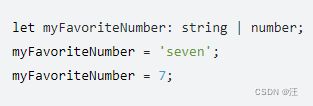TypeScript快速入门
基础类型
条件语句
条件语句用于基于不同的条件来执行不同的动作。TypeScript 条件语句是通过一条或多条语句的执行结果(True 或 False)来决定执行的代码块。
| 类型 | 定义 | ||
|---|---|---|---|
| if 语句 | if | 语句由一个布尔表达式后跟一个或多个语句组成 | var num:number = 5; if (num > 0) { console.log(‘数字是正数’) } |
| if…else 语句 | if…else | 一个 if 语句后可跟一个可选的 else 语句,else 语句在布尔表达式为 false 时执行。 | var num:number = 12; if (num % 2==0) { console.log(‘偶数’); } else {console.log(‘奇数’); } |
| if…else if…else 语句 | if…else if…else | 执行多个判断条件的时候很有用。 | var num:number = 2;if(num > 0) { console.log(num+’ 是正数’) } else if(num < 0) { console.log(num+’ 是负数’) } else { console.log(num+’ 为0’) } |
| switch…case 语句 | switch…case | 一个 switch 语句允许测试一个变量等于多个值时的情况。每个值称为一个 case,且被测试的变量会对每个 switch case 进行检查。 | var grade:string = ‘A’; switch(grade) { case ‘A’: { console.log(‘优’); break; } case ‘B’: { console.log(‘良’); break; } default: { console.log(‘非法输入’); break; }} |
函数
函数是一组一起执行一个任务的语句,函数声明要告诉编译器函数的名称、返回类型和参数。TypeScript可以创建有名字的函数和匿名函数,其创建方法如下:
// 有名函数
function add(x, y) {
return x + y;
}
// 匿名函数
let myAdd = function (x, y) {
return x + y;
};
为函数定义类型
为了确保输入输出的准确性,我们可以为上面那个函数添加类型:
// 有名函数:给变量设置为number类型
function add(x: number, y: number): number {
return x + y;
}
// 匿名函数:给变量设置为number类型
let myAdd = function (x: number, y: number): number {
return x + y;
};
可选参数
在TypeScript里我们可以在参数名旁使用 ?实现可选参数的功能。 比如,我们想让lastName是可选的:
function buildName(firstName: string, lastName?: string) {
if (lastName)
return firstName + ' ' + lastName;
else
return firstName;
}
let result1 = buildName('Bob');
let result2 = buildName('Bob', 'Adams');
剩余参数
剩余参数会被当做个数不限的可选参数。 可以一个都没有,同样也可以有任意个。 可以使用省略号( …)进行定义:
function getEmployeeName(firstName: string, ...restOfName: string[]) {
return firstName + ' ' + restOfName.join(' ');
}
let employeeName = getEmployeeName('Joseph', 'Samuel', 'Lucas', 'MacKinzie');
箭头函数
ES6版本的TypeScript提供了一个箭头函数,它是定义匿名函数的简写语法,用于函数表达式,它省略了function关键字。箭头函数的定义如下,其函数是一个语句块:
( [param1, parma2,…param n] )=> {
// 代码块
}
其中,括号内是函数的入参,可以有0到多个参数,箭头后是函数的代码块。我们可以将这个箭头函数赋值给一个变量,如下所示:
let arrowFun = ( [param1, parma2,…param n] )=> {
// 代码块
}
如何要主动调用这个箭头函数,可以按如下方法去调用:
arrowFun(param1, parma2,…param n)
接下来我们看看如何将我们熟悉的函数定义方式转换为箭头函数。我们可以定义一个判断正负数的函数,如下:
function testNumber(num: number) {
if (num > 0) {
console.log(num + ' 是正数');
} else if (num < 0) {
console.log(num + ' 是负数');
} else {
console.log(num + ' 为0');
}
}
其调用方法如下:
testNumber(1) //输出日志:1 是正数
如果将这个函数定义为箭头函数,定义如下所示:
let testArrowFun = (num: number) => {
if (num > 0) {
console.log(num + ' 是正数');
} else if (num < 0) {
console.log(num + ' 是负数');
} else {
console.log(num + ' 为0');
}
}
其调用方法如下:
testArrowFun(-1) //输出日志:-1 是负数
后面,我们在学习HarmonyOS应用开发时会经常用到箭头函数。例如,给一个按钮添加点击事件,其中onClick事件中的函数就是箭头函数。
Button("Click Now")
.onClick(() => {
console.info("Button is click")
})
类
TypeScript支持基于类的面向对象的编程方式,定义类的关键字为 class,后面紧跟类名。类描述了所创建的对象共同的属性和方法。
类的定义
例如,我们可以声明一个Person类,这个类有3个成员:一个是属性(包含name和age),一个是构造函数,一个是getPersonInfo方法,其定义如下所示。
class Person {
private name: string
private age: number
constructor(name: string, age: number) {
this.name = name;
this.age = age;
}
public getPersonInfo(): string {
return `My name is ${this.name} and age is ${this.age}`;
}
}
通过上面的Person类,我们可以定义一个人物Jacky并获取他的基本信息,其定义如下:
let person1 = new Person('Jacky', 18);
person1.getPersonInfo();
继承
继承就是子类继承父类的特征和行为,使得子类具有父类相同的行为。TypeScript中允许使用继承来扩展现有的类,对应的关键字为extends。
class Employee extends Person {
private department: string
constructor(name: string, age: number, department: string) {
super(name, age);
this.department = department;
}
public getEmployeeInfo(): string {
return this.getPersonInfo() + ` and work in ${this.department}`;
}
}
通过上面的Employee类,我们可以定义一个人物Tom,这里可以获取他的基本信息,也可以获取他的雇主信息,其定义如下:
let person2 = new Employee('Tom', 28, 'HuaWei');
person2.getPersonInfo();
person2.getEmployeeInfo();
在TypeScript中,有public、private、protected修饰符,其功能和具体使用场景大家可以参考TypeScript的相关学习资料,进行拓展学习。
模块
随着应用越来越大,通常要将代码拆分成多个文件,即所谓的模块(module)。模块可以相互加载,并可以使用特殊的指令 export 和 import 来交换功能,从另一个模块调用一个模块的函数。
两个模块之间的关系是通过在文件级别上使用 import 和 export 建立的。模块里面的变量、函数和类等在模块外部是不可见的,除非明确地使用 export 导出它们。类似地,我们必须通过 import 导入其他模块导出的变量、函数、类等。
导出
任何声明(比如变量,函数,类,类型别名或接口)都能够通过添加export关键字来导出,例如我们要把NewsData这个类导出,代码示意如下:
export class NewsData {
title: string;
content: string;
imagesUrl: Array<NewsFile>;
source: string;
constructor(title: string, content: string, imagesUrl: Array<NewsFile>, source: string) {
this.title = title;
this.content = content;
this.imagesUrl = imagesUrl;
this.source = source;
}
}
导入
模块的导入操作与导出一样简单。 可以使用以下 import形式之一来导入其它模块中的导出内容。
import { NewsData } from '../common/bean/NewsData';
迭代器
当一个对象实现了Symbol.iterator属性时,我们认为它是可迭代的。一些内置的类型如Array,Map,Set,String,Int32Array,Uint32Array等都具有可迭代性。
for…of 语句
for…of会遍历可迭代的对象,调用对象上的Symbol.iterator方法。 下面是在数组上使用for…of的简单例子:
let someArray = [1, "string", false];
for (let entry of someArray) {
console.log(entry); // 1, "string", false
}
for…of vs. for…in 语句
for…of和for…in均可迭代一个列表,但是用于迭代的值却不同:for…in迭代的是对象的键,而for…of则迭代的是对象的值。
let list = [4, 5, 6];
for (let i in list) {
console.log(i); // "0", "1", "2",
}
for (let i of list) {
console.log(i); // "4", "5", "6"
}
